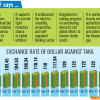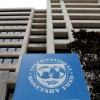Currency unleashed: Handle with care

The Bangladesh Bank (BB) has, somewhat unexpectedly, reverted to the exchange rate regime announced on December 31, 2024, effectively transitioning the country into a free-floating currency system. Authorised dealers are now permitted to buy and sell foreign currency at freely negotiated rates, allowing the taka to be determined by market forces rather than being pegged or constrained within a fixed range. BB has also repealed the January 2, 2025, circular that imposed a Tk 1 spread between buying and selling rates.
This decision is a pragmatic step, regardless of whether it was motivated by the necessity of meeting IMF program conditions for the 4th and 5th disbursements. The market appears ready to move beyond the previous "crawling peg" system, which maintained a fixed spread and a ceiling on selling rates for authorised dealers. Following the settlement of several accumulated payments in December, conditions in the foreign exchange market improved—remittances surged, imports remained weak, and illicit capital outflows continued slumping. As a result, the policy-imposed spread and ceiling often failed to be binding. BB hardly sold dollars in the market in the last five months.
This shift toward a flexible exchange rate regime represents an opportunity for market participants to adapt to a framework that prioritises responsiveness to global and local economic factors. It is a bold step signalling confidence in the ability of the market to determine fair and competitive exchange rates without relying on heavy-handed intervention. By tethering less to fixed policies and more to macroeconomic realities, the switch aligns with international practices, providing an avenue for greater integration into the global financial system.
Bangladesh is inherently vulnerable to external shocks, including volatile global commodity prices, economic downturns among major trading partners, and natural disasters. If the BB maintains its commitment to a flexible exchange rate, without abrupt policy reversals seen in the past, the taka can adjust dynamically in response to these external pressures. This shift will reduce the need for constant intervention by BB, alleviating the strain on foreign exchange reserves and removing the complexities of monitoring currency market operations.
A flexible exchange rate empowers businesses and investors to engage in transactions based on actual market conditions rather than depending on BB for foreign exchange access. This leads to more efficient pricing of goods, services, and investments, fostering economic agility. Foreign investors often favour economies with market-driven exchange rates, as they enhance transparency and minimise risks associated with sudden policy-driven currency fluctuations.
Market efficiency cannot be taken for granted. Fortunately, the BB has already implemented a reporting system that provides foreign exchange transaction data twice daily for transactions of one lac US dollars or more. This mechanism is now fully operational. Additionally, BB publishes a daily reference benchmark rate, calculated as the weighted average of rates reported by ADs. With no incentive to misreport under the new regime, this would serve as a valuable anchor for setting competitive exchange rates.
Every exchange rate regime must strike a balance between rate flexibility and pressure on foreign exchange reserves. A flexible system reduces the burden on reserves by allowing the exchange rate to adjust naturally in response to supply or demand fluctuations. However, if such fluctuations lead to excessive volatility, the need for intervention using official reserves increases. To counter this, BB is committed to employing a market-based intervention strategy designed to deter speculative behaviour and address sudden shortages in foreign currency.
With a flexible exchange rate, BB can now shift its focus toward domestic economic priorities such as inflation control, employment growth, and financial stability instead of continuously defending the currency. That said, effective management of the float requires ongoing vigilance. Several countries—including India, Singapore, Indonesia, and Brazil—have successfully balanced market-driven currency valuation with strategic interventions, providing useful models for Bangladesh to follow. Moreover, Bangladesh's own experience from 2003 to 2022 reinforces the confidence that it can manage this system effectively.
BB should intervene only when necessary, such as during periods of natural disasters or large, unanticipated financial shocks. Maintaining adequate foreign exchange reserves would enable BB to support the taka to cope with such shocks while instilling investor confidence. Regular and transparent communication from the BB on monetary and exchange rate policies would help prevent speculation and panic. Ensuring strong coordination between monetary and fiscal policies would further safeguard against risks associated with currency fluctuations.

 For all latest news, follow The Daily Star's Google News channel.
For all latest news, follow The Daily Star's Google News channel. 








Comments